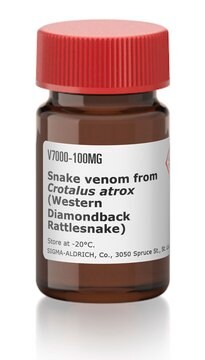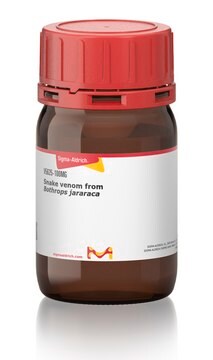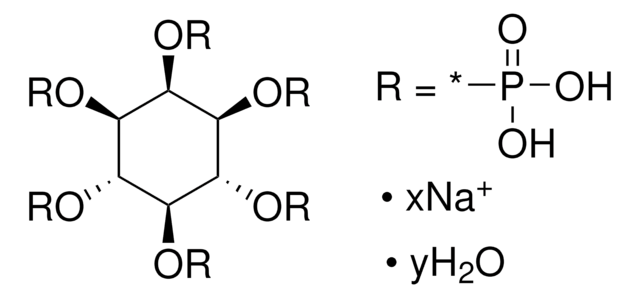E0504
Ecarin from Echis carinatus venom
prothrombin activator
Se connecterpour consulter vos tarifs contractuels et ceux de votre entreprise/organisme
About This Item
Produits recommandés
Source biologique
Echis carinatus venom
Niveau de qualité
Conditionnement
vial of 45-55 units
Température de stockage
−20°C
Application
Ecarin activity is the principal behind the Ecarin Clotting Time (ECT) assay, which is used to assess antithrombotic effect and thrombin inhibition.
Ecarin from Echis carinatus venom is the primary reagent in the ecarin clotting time (ECT) test, which is used to monitor anticoagulation and thrombin inhibition. It has been used in studies to test the effectiveness of medications for the treatment of venous and arterial thromboembolism.
Actions biochimiques/physiologiques
Prothrombin activator
Définition de l'unité
One unit will activate prothrombin to produce one unit of amidolytic activity at pH 8.4 at 37 °C. One amidolytic unit will hydrolyze 1.0 μmole of N-p-tosyl-Gly-Pro-Arg-p-nitroanilide per min at pH 8.4 at 37 °C.
Mention d'avertissement
Danger
Mentions de danger
Conseils de prudence
Classification des risques
Resp. Sens. 1 - Skin Sens. 1
Code de la classe de stockage
11 - Combustible Solids
Classe de danger pour l'eau (WGK)
WGK 3
Point d'éclair (°F)
Not applicable
Point d'éclair (°C)
Not applicable
Équipement de protection individuelle
dust mask type N95 (US), Eyeshields, Faceshields, Gloves
Faites votre choix parmi les versions les plus récentes :
Déjà en possession de ce produit ?
Retrouvez la documentation relative aux produits que vous avez récemment achetés dans la Bibliothèque de documents.
Elise S Eerenberg et al.
Circulation, 124(14), 1573-1579 (2011-09-09)
Rivaroxaban and dabigatran are new oral anticoagulants that specifically inhibit factor Xa and thrombin, respectively. Clinical studies on the prevention and treatment of venous and arterial thromboembolism show promising results. A major disadvantage of these anticoagulants is the absence of
Wei Zhou et al.
Stroke, 42(12), 3594-3599 (2011-10-15)
Dabigatran-etexilate (DE) recently has been approved for stroke prevention in atrial fibrillation. However, lack of effective antagonists represents a major concern in the event of intracerebral hemorrhage (ICH). The aims of the present study were to establish a murine model
Lambro A Johnson et al.
Analytical biochemistry, 608, 113907-113907 (2020-08-20)
Snake venom prothrombin activators such as Ecarin are readily assayed by continuous spectrophotometric monitoring of p-nitroaniline production in a one step assay containing prothrombin and a p-nitroanilide peptide substrate for thrombin. The coupled reactions result in accelerating p-nitroaniline (pNA) production
Kevin Dietrich et al.
Thrombosis research, 135(4), 630-635 (2015-02-27)
Age-related changes in the hemostatic system result in variation in response to anticoagulants and coagulation assays over childhood. This study used in vitro methods to determine i) optimum coagulation assays for dabigatran in children and ii) anticoagulant effect of dabigatran
Notre équipe de scientifiques dispose d'une expérience dans tous les secteurs de la recherche, notamment en sciences de la vie, science des matériaux, synthèse chimique, chromatographie, analyse et dans de nombreux autres domaines..
Contacter notre Service technique









